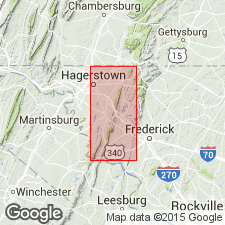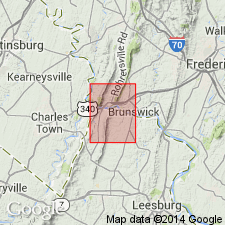
- Usage in publication:
-
- Buzzard Knob Member
- Modifications:
-
- Named
- Dominant lithology:
-
- Quartzite
- AAPG geologic province:
-
- Piedmont-Blue Ridge province
Summary:
Named the Buzzard Knob Member of the Weverton Formation for Buzzard Knob, near Smithsburg, Washington Co., MD. Unit extends into PA and VA. Consists of medium-light-gray to light-gray, medium- to coarse-grained, medium-bedded quartzite. Thickness is 125 to 175 feet. Overlies the Loudoun Formation and underlies the Maryland Heights Member of the Weverton Formation. Upper contact is placed where quartzite of the Buzzard Knob abruptly changes to phyllite of the Maryland Heights.
Source: GNU records (USGS DDS-6; Reston GNULEX).

- Usage in publication:
-
- Buzzard Knob Member*
- Modifications:
-
- Areal extent
- AAPG geologic province:
-
- Piedmont-Blue Ridge province
Summary:
Geographically extended the Buzzard Knob Member of the Weverton Formation into easternmost WV. In MD, WV, and VA, the Buzzard Knob consists of light-gray to medium light-gray, medium- to fine-grained, well-sorted, graded and cross-bedded quartzite. Unit is massive to thick bedded at base and top. Lower part is locally arkosic. Middle part is thin bedded and contains light-gray phyllitic metagraywacke and metasiltstone. Overlies the Loudoun Formation, Catoctin Formation, or locally, basement gneiss, and underlies the Maryland Heights Member of the Weverton.
Source: GNU records (USGS DDS-6; Reston GNULEX).
For more information, please contact Nancy Stamm, Geologic Names Committee Secretary.
Asterisk (*) indicates published by U.S. Geological Survey authors.
"No current usage" (†) implies that a name has been abandoned or has fallen into disuse. Former usage and, if known, replacement name given in parentheses ( ).
Slash (/) indicates name conflicts with nomenclatural guidelines (CSN, 1933; ACSN, 1961, 1970; NACSN, 1983, 2005, 2021). May be explained within brackets ([ ]).

